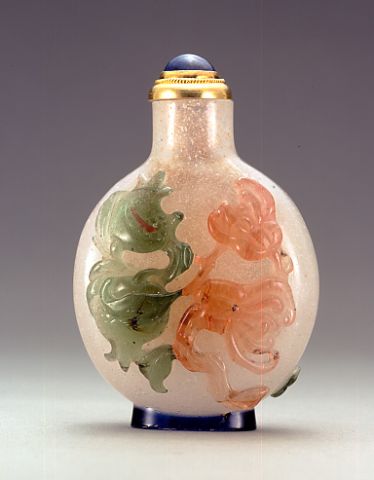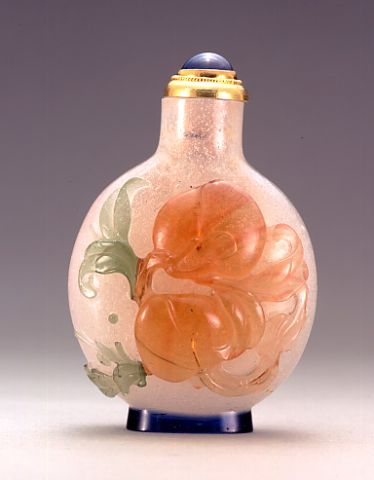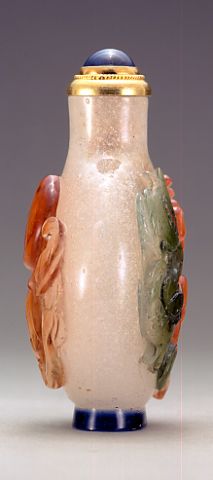


Bottle ID: 00511
SNOWFLAKE W/BLUE, GREEN & ORANGE OVERLAY, FRUITS
Date: 1740-1780
Height: 62 mm
Glass, of rounded form tapering to a long neck and wide mouth, overlaid on a bubbly snowflake ground, with three colors of sapphire-blue, streaky emerald- green and streaky orange-pink, carved on one side with a leafy branch of peaches, the reverse with a leafy branch of two ripe, open pomegranates and two finger citrons, and with a well carved footrim.
Possibly Imperial, attributed to the Palace Workshops, Beijing.
Similar Examples:
Moss, Hugh, Victor Graham and Ka Bo Tsang. A Treasury of Chinese Snuff Bottles - The Mary and George Bloch Collection, 2002, Vol. 5, Part 3, p. 638, no. 984; and p. 669, no. 998.
Provenance:
Hugh Moss [Hk] Ltd.
Exhibited:
Annual Convention ICSBS Toronto, October 2007
This bottle is part of a well defined group of bottles made in the latter half of the Qianlong period. This group tends to exhibit similar characteristics not only in terms of manufacture, but also in terms of style and subject matter. The 'streakiness' which is apparent in the overlay color, this time in opaque cinnabar-red within the green overlay, is seen on other examples as are the black ash flakes (from the glass furnace) seen in the footrim. A further characteristic of the manufacturing process seems to be the internal fissures which occur in the ground, directly under the overlay. This implies that either the cooling process or the lapidary process caused tension between the ground and the overlay, resulting in a fissure only on the lower layer of the glass. Such features as the highly defined splayed deep foot and the wide mouth point to an eighteenth century dating for this group and to an attribution to the Palace Workshops, where the finest objects were being produced with the greatest amount of skill.
The fruit portrayed on this bottle are collectively known as the 'Three Abundances' referring to abundance and plenty, and symbolizing the phrase 'may you live a long life with many sons and every happiness'. The pomegranate shown with its ripe seeds represents fertility and, therefore, the wish for many children. The Chinese word 'zi' means both 'seeds' and 'sons', consequently an open pomegranate is often depicted on a wedding gift. The peach is one of the most often illustrated fruits in Chinese art and is the emblem of immortality, while the finger citron or Buddha's hand symbolizes long life and happiness. On this snuff bottle, each fruit is shown in pairs offering the good wishes twice over.

 English
English 中文
中文